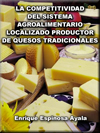LA COMPETITIVIDAD DEL SISTEMA AGROALIMENTARIO LOCALIZADO PRODUCTOR DE QUESOS TRADICIONALES
Enrique Espinosa Ayala
Esta página muestra parte del texto pero sin formato.
Puede bajarse la tesis completa en PDF comprimido ZIP (198 páginas, 749 kb) pulsando aquí
Value Generation in Traditional Milk – Cheese Chains. An option for the Mexican Highlands
Abstract
The traditional dairy (milk-cheese) chain was characterized in a municipality in the Mexican highlands, selecting 28 small-scale dairy farms (SDF), 16 milk collectors and 12 rural cheese factories. Questionnaires were applied and an economic analysis through activity budgets was performed. Finally the generation of value was obtained using the methodology of Competitiveness with Equity in Agro-alimentary chains using values for a kilogram of cheese. SDF which delivered milk directly to cheese factories had an annual gross margin (GM) of USD$ 2,037, whereas for those which delivered to a collector GM was USD$1,987. Collectors obtained a GM of USD$ 5,224. The cheese factories were divided into traditional, diversified and commercial, where GM was USD$ 30,044, USD$ 32,194, and USD$ 55,490, respectively. Cheese factories generate the most value, whereas SDF cover the largest proportion of costs and obtain the lowest margin. The milk-cheese chain is competitive as the final product is commercialized and it generates value, nonetheless inequity is observed in the distribution of value among the different links that make up the chain.
Key Words: Agro chains, value generation and competitiveness, small-scale dairying, Mexico.
Generación de valor en la cadena tradicional leche-queso. Una opción para el altiplano mexicano
Resumen
Se caracterizó una cadena tradicional leche queso en un municipio del altiplano mexicano, se seleccionaron 28 unidades de producción de leche en pequeña escala (UPLPE), 16 recolectores de leche y 12 queserías rurales. Se aplicaron cuestionarios y análisis económicos empleando la metodología de Presupuestos por Actividad, finalmente se obtuvo la generación de valor con la metodología de Competitividad con Equidad en Cadenas Agroalimentarias, para esto se utilizaron valores equivalentes en kilogramos de queso. Las UPLPE que entregan la leche directamente a las queserías obtuvieron un Margen Bruto (MB) de USD$2,037, mientras que los que entregan al recolector el MB fue de USD$1,987. Los recolectores obtuvieron un MB de USD$5,224. Las queserías se dividieron en tradicionales, diversificadas y comerciales, las cuales obtuvieron un MB de USD$30,044, USD$32,194 y USD$55,490 respectivamente. Las queserías generaron más valor, mientras que las UPLPE absorbieron la mayor proporción del costo y obtuvieron el menor margen. La cadena leche quesos es competitiva ya que comercializó el producto final y generó valor, aunque se observó una inequidad en la distribución del valor entre los eslabones que integran la cadena.
Palabras clave: Agrocadenas de valor, generación de valor y competitividad, lechería en pequeña escala, México
INTRODUCTION
Dairying in Mexico is a dynamic activity that showed an average annual growth rate of 3.22% from 1990 to 2007, reaching a production of 10,290,089 tons in 2007, which represented around 9.4% of the total agricultural product in 2006. Despite the growth in supply, total demand is not met, leading to a dependency on importation of 13% for fluid milk and 37.8% for dairy products such as cheese (SIAP, 2008; FAO, 2008).
The Mexican dairy industry is conformed by two main areas for analysis: the market for liquid milk, dominated by large companies that represents 41.6% of the national production (Espinosa et al., 2006); and the market of dairy products where, apart from the large companies, there is a broad sector of small-scale enterprises which elaborate traditional cheeses and commercialize them in local and regional markets (Espinoza-Ortega et al., 2007).
These small agro-industries are mainly concentrated in rural areas; they obtain their resources from specific territories, and favour the creation of production chains as they are articulated with small dairy farms and diverse marketing channels; which allow them to be analyzed with the Localized Agro-food Systems (LAFS) approach, as proposed by Boucher and Requier-Desjardins (2005).
The LAFS are organizations of production and service in a specific territory. The environment, the products, the people, their institutions, their know-how, their food culture, and their networks of relations, are combined in a territory to produce a form of agro-alimentary organization in a given space (Boucher and Requier-Desjardins, 2005).
Elements of analysis in LAFS include territory, rural agro-industry and their products together with their commercialization, which establish the rural-urban link. LAFS are in the crossroads of production chains and territorial networks; this chain-territory relationship can be considered as a particular element of the agro-alimentary sector (Boucher and Requier-Desjardins, 2005). The LAFS favour competitiveness of the chain, defining it as the capacity of the chain to maintain and broaden its participation in the markets in a profitable manner and generating value (Porter, 1998).
An example of LAFS is the concentration of small-scale cheese factories in the northwest of the State of Mexico in the Central Highlands, which are articulated with small dairy farms, milk collectors and cheese merchants (Castañeda-Martínez et al., in print), thus integrating a traditional milk-cheese chain, linked to a specific territory; which as happens to other small enterprises in the country, face the importation of finished products and supplies at low prices, and disloyal competition with analogue cheeses, which could put its competitiveness risk.
Espinoza-Ortega et al. (2007) studied the small-scale dairy farms in the area in technical and economic terms in the light of the contribution of milk production towards poverty alleviation. However, it has been proposed that there is a need to implement value-added activities as a necessary condition for improving the livelihoods of rural people (Reardon and Barrett, 2000), that provide employment and opportunities beyond primary production.
The objective of this work was to analyze a traditional milk-cheese chain in the highlands of the Central Mexico (at an altitude over 2,300 m), in order to obtain the generation of value along the chain to determine its competitiveness, as well as to determine if this productive chain is a rural development option, analyzed under the LAFS approach.


